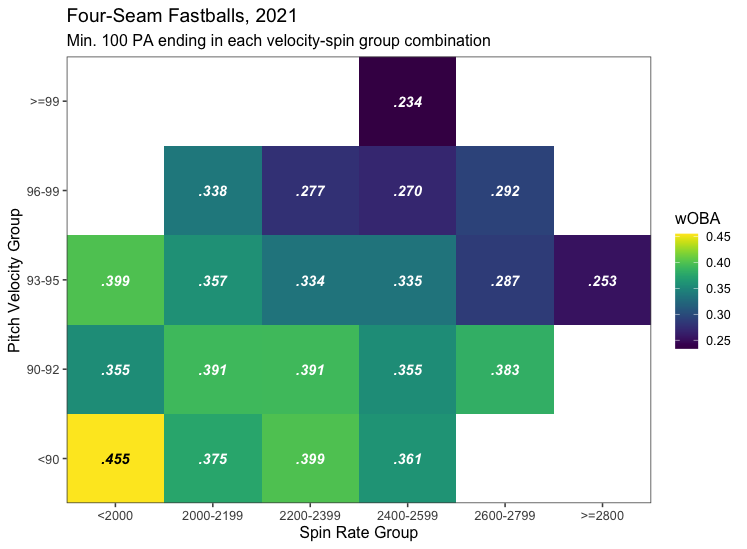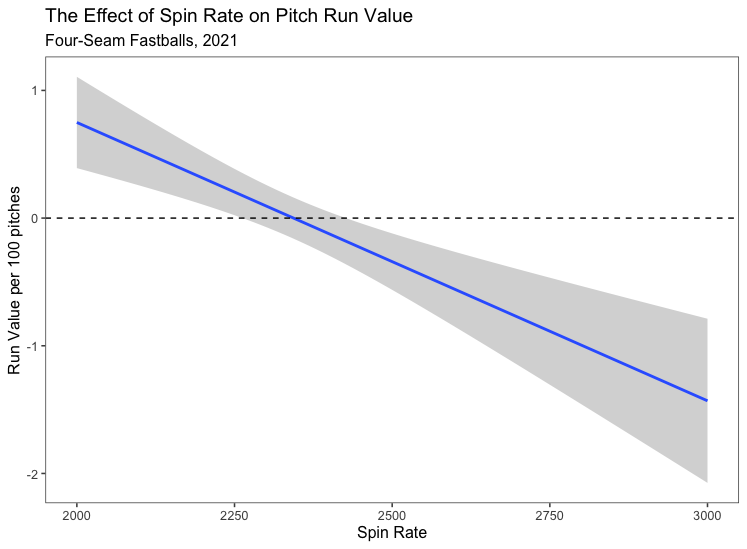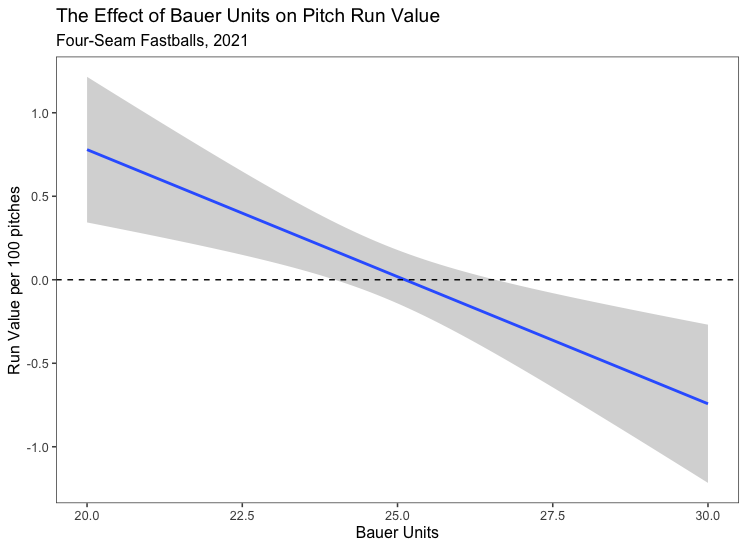More Spin, More Problems: Hitter Performance Against High-Spin Fastballs
Major League Baseball is preparing to crack down on pitchers’ use of foreign substances, which could have important ramifications for how the game is played not just the rest of this season, but for a long time to come. Such a remarkable midseason change in enforcement — one report from ESPN’s Buster Olney suggested that umpires might randomly check baseballs 8–10 times per game — could alter league-wide offense, perhaps to a rather large degree depending on the number of pitchers who doctor the baseball.
Two things seems fairly certain, though. First, foreign substances increase spin rates; second, spin rates significantly impact pitcher performance. An experiment run by Travis Sawchik at theScore demonstrated that certain substances, like Spider Tack, could add as much as 500 rpms to a fastball. One college pitcher, Spencer Curran from Seton Hall University, saw the baseline rpm on his fastball go from 2,096 without any substances to 2,516 with Spider Tack and without any velocity increase — a jump that likely cannot happen naturally.
“It’s probably pretty hard to change that [fastball spin] ratio for an individual,” University of Illinois physics professor Alan Nathan told Sawchik at FiveThirtyEight. “I can see that you could do it for a curveball because a curveball involves some technique, whereas a fastball is pure power. There is no finesse.”
In a comprehensive story published by Stephanie Apstein and Alex Prewitt at Sports Illustrated, one recently retired pitcher estimated that 80% to 90% of pitchers currently use some form of foreign substances. But even with pervasive use, not all sticky stuff has the same impact. As Sawchik showed in his experiment, some substances — like a sunscreen mix he used — may actually decrease spin rates. Some of it may depend on how much time each pitcher has had to experiment in front of a Rapsodo, trying different concoctions until something works to their liking.
In both articles, the authors highlighted some basic stats to show how spin rate impacts batter performance. Sawchik noted that batters are hitting .264 on four-seam fastballs that range from 2,250–2,350 rpms, but just .217 on those above 2,500. That’s a sizable gap, and numbers like that have definitely caught MLB’s attention. As one executive told SI, though MLB is considering many changes to increase offense, he believes that better enforcement of the foreign substances rule already on the books — Rule 6.02(c) — would go a long way.
“I think people would be absolutely shocked if they actually enforced this, how much you’ll start to normalize things without rule changes,” the executive said.
This got me thinking: Is there a more comprehensive way to evaluate batter performance by spin rate? Prior studies have looked into this, including Higuchi et al., who found that batters consistently made poorer contact on fastballs with more spin. Others, like Zach Day at Baseball Prospectus in 2013, found that higher spin fastballs elicited more swings and misses and fewer groundballs, with lower spin fastballs yielding the reverse. Driveline Baseball provides a comprehensive breakdown of spin rates and how they relate to performance, with the idea that higher spin fastballs tend to perform better in terms of whiffs and, as a result, strikeouts.
I wanted to take this one step further. To get some idea of just how much batters are struggling as a result of increased spin rates, I downloaded every single plate appearance-ending four-seam fastball from the 2021 season through games on June 3. (For reference, hitters had posted a .342 wOBA against that pitch through that date.) Next, I binned them by pitch velocity and spin rate, with five groups for velo and six groups for spin. Then, I calculated the league-average wOBA for each velocity-spin combination and filtered out those with fewer than 100 total plate appearances. This is what I found:

Perhaps most telling is the 93–95 mph velocity group. Hitters posted a .399 wOBA in 388 plate appearances against fastballs that were in this range and had a spin rate below 2,000 rpms, but as we move across the table to higher spin rates, that performance gets noticeably worse. For fastballs thrown between 93–95 mph and at a spin rate of at least 2,800 rpms, batters saw a a 146-point decrease in wOBA, down to .253 in 119 plate appearances. This chart also shows the impact of velocity on performance; as you move up across each spin rate group, hitters have produced worse results, as you would expect.
This chart isn’t a perfect representation of hitter performance. Velocity and spin rate are interrelated. Pitches with higher velocities have higher spin rates, so while a 93–95 mph pitch group may look like we’re holding things constant — and, to be fair to myself, we mostly are — a spin rate of 2,800 rpms is much more likely to come on a 95-mph fastball than a 93-mph fastball even though they are in the same group. And since velocity does influence outcomes, we might not be totally capturing what we want here, though the overall trend, where things will even out a bit more, is pretty clear.
That’s why I also looked at batter performance by Bauer Units, which is effectively a velocity-adjusted spin rate. It’s a simple calculation — RPM/MPH — but it does the trick at calculating velocity-independent spin and rewarding pitchers if they have an abnormally-high spin rate on pitches with lower velocity even if those raw spin rates are not as high as those on pitches of higher velocity. The league-average four-seam velocity this season is 93.7 mph, and the league-average spin rate this season is 2,317 rpms, so the league-average Bauer Units on the four-seam fastball this season is 24.7.
With that in mind, I did the same thing as above, calculating the Bauer Unit value for each plate appearance-ending four-seam fastball this season, binning them appropriately, and figuring out the resulting wOBAs. The trend here is as clear as day:

There are small samples on both ends, but even just comparing the 22–23 BU group (5,642 PA) to the 26–27 BU group (4,198 PA), we get a good idea of the impact of spin on performance. Batters have performed 7% worse against pitches in the latter group than they did in the former, representing a rather enormous change for a sample size that large and giving us a small glimpse into just how league offense might be impacted by effective crackdown on foreign substances. In Sawchik’s experiment, Spider Tack increased Curran’s RPM/MPH ratio from his baseline of 24.1 to 29.9, a jump that would turn the pitch from being about average to nearly unhittable.
I wasn’t done with the research, though; I still wanted to evaluate the impact of spin rate and Bauer Units on pitch performance on pitches in the middle of a plate appearance. There’s a potentially huge confound from looking at only fastballs that end plate appearances: If these pitches are different in any way from all four-seam fastballs, then the data would be less telling. I didn’t think that in a sample this large — all four-seam fastballs — we would see something significant, but to cover all my bases, I looked at the impact of spin and Bauer Units on pitch run values for four-seam fastballs.
First, spin rate:

Now, Bauer Units:

As you can see, as spin rates and Bauer Units increase, run values go down, which is exactly what pitchers want. A simple linear model demonstrated that, on average, an increase in 100 rpms on the four-seam fastball increased the pitch’s run value by 0.2 runs per 100 pitches. An increase in one Bauer Unit, meanwhile, increased the pitch’s run value by 0.16 runs per 100 pitches. Curran, for example, increased his BU from 24.1 to 29.9 using Spider Tack, a jump that would be expected to increase his pitch’s run value by 0.93 runs per 100 pitches. And considering major league starters throw more than 1,500 four-seam fastballs in a season, the use of foreign substances could legitimately be earning them extra wins of value. That is mind-boggling to consider.
And this is just an analysis of the four-seam fastball. Other pitches benefit from more spin as well, as it yields more movement. But considering just how much batters struggle on higher velocity-adjusted spin rates, I don’t think I would be totally surprised to see a noticeable increase in league-wide offense if MLB swiftly and effectively figures out how to crack down on substances giving pitchers the spin rate edge.
Devan Fink is a Contributor at FanGraphs. You can follow him on Twitter @DevanFink.

It would be interesting to see if there are particular hitters who do better or worse against high spin fastballs so we could project some winners/losers to the upcoming changes.
I’m wondering if groundball hitters show better performance against high-Bauer Unit fastballs.